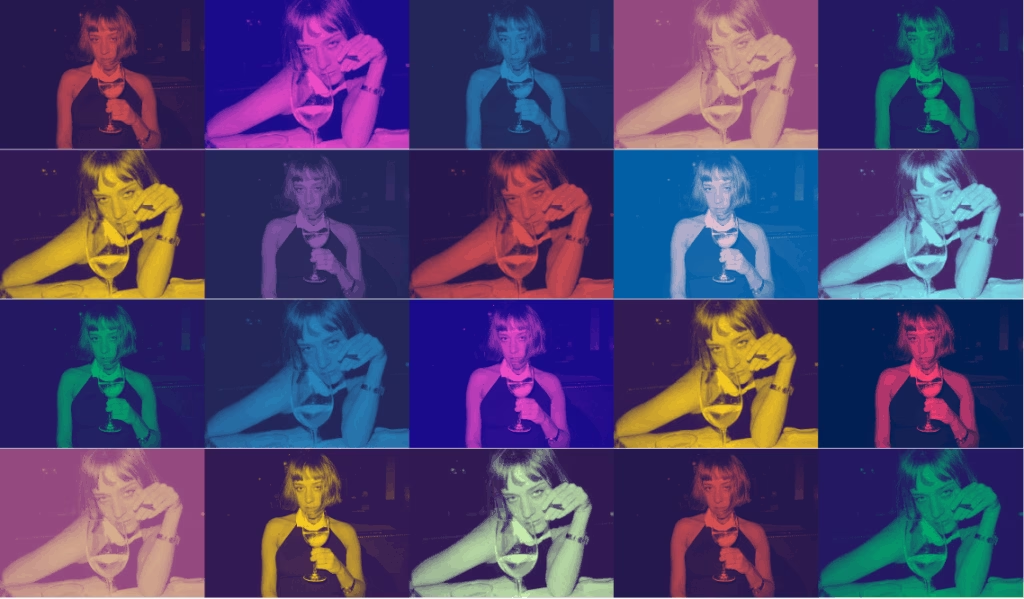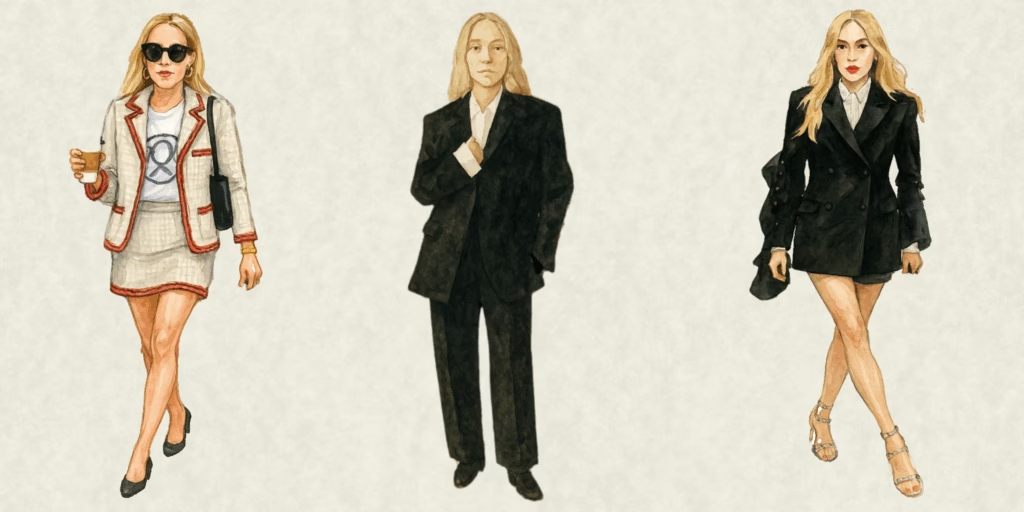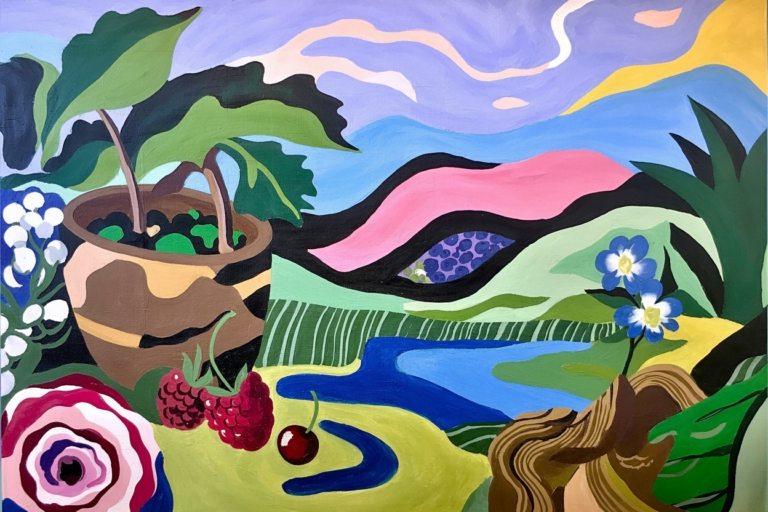Vintage Vines, Vintage Vibes: The Rhône Valley
Rhône Valley wines bring depth and diversity without shouting for attention. Think Chloë Sevigny: stylish without trying, and the kind of cool that can’t be manufactured.

If Bordeaux is the Spice Girls of French wine—iconic, polished, and meticulously produced—then you can liken the Rhône Valley (and her wines) to an indie darling. Think Chloë Sevigny: stylish without trying, and the kind of cool that can’t be manufactured. Rhône Valley wines bring depth and diversity without shouting for attention. Instead of standing center stage in the spotlight, think sipping something earthy under string lights, wearing vintage Dior, and somehow making it all look effortless.
From the steep slopes of the Northern Rhône to the sun-baked plateaus of the Southern Rhône, this valley is one of France’s oldest and most soulful wine regions. It’s also one of its most dynamic, producing reds, whites, and rosés that range from everyday drinkers to cellar-worthy icons—all with the Rhône’s signature cool.
Let’s swirl through the geography, climate, subregions, and wines that define her.
A Tale of Two Rhônes, Like the Styles of Two Chloës
The Rhône River flows south from Lyon to the Mediterranean, dividing the valley into two distinct personalities:
- Northern Rhône has a continental climate with cold winters, hot summers, and steep slopes. Vines cling to granite terraces above the river—growing is labor-intensive but worth it. Most wines are single varietals (wines made from just one grape variety, rather than a blend) and often from a single vineyard, showcasing purity and precision.
- Southern Rhône basks in a Mediterranean climate with long, dry summers and mild winters. The infamous Mistral wind barrels through, drying grapes and keeping mildew in check. The terroir is diverse, featuring galets roulés (big river stones), limestone, clay, and sandy soils. Unlike in the Northern Rhône, most wines here are blends—layered and expressive.
Though both fall under the Rhône umbrella, they’re stylistically different—and together, they show just how versatile this wine region can be.
The Northern Rhône: Syrah, Structure, and Monochromes

If the Rhône Valley is Chloë Sevigny, then the Northern Rhône is her in monochrome (think The Row, Calvin Klein, Chanel, and power suit after power suit): understated, cerebral, and effortlessly chic. The Northern Rhône is the birthplace of Syrah, the only red grape permitted here, which thrives on the granite slopes that run along the riverbanks.
Syrah-based reds from the Northern Rhône are intense, age-worthy, and alive with notes of blackberry, cracked pepper, black olive, and smoked herbs. They’re often fermented with their stems for extra tannic structure and aged in neutral oak or large barrels to highlight the grape rather than mask it.
The white wines here are just as compelling, made from Viognier, Marsanne, and Roussanne. Viognier, especially from Condrieu, offers lush, floral aromatics—think apricot, jasmine, and beeswax—while Marsanne and Roussanne, often blended, produce structured, savory whites with a creamy texture and mineral lift.
Major Norther Rhône Appellations and Their Grapes:
- Côte-Rôtie – Syrah (with a touch of Viognier), known for elegance and aromatics
- Hermitage – Powerful and structured Syrah and Marsanne-Roussanne whites
- Cornas – 100% Syrah, bold and brooding (Cornas Syrahs got me into the grape)
- Saint-Joseph – Lighter, fruit-driven Syrah, often an entry point to the north
- Crozes-Hermitage – Broad and accessible Syrah with freshness and spice
- Condrieu – 100% Viognier, unctuous and aromatic
The Southern Rhône: Blending Grapes and Mixing Patterns

In stark contrast to the Northern Rhône’s restraint, the Southern Rhône is the valley in color: sun-soaked, generous, and bursting with character—evocative of Sevigny print and texture matching, including through partnerships with more feminine and playful labels like Chloé, Kenzo, Loewe, and Miu Miu.
Here, Grenache takes center stage, supported by an ensemble cast including Syrah, Mourvèdre, Cinsault, and Carignan. These red blends are warm and open-hearted, full of ripe red berries, dried herbs, and garrigue (low-lying Mediterranean shrubs, aromatic herbs, and bunch grasses often growing in the region’s limestone soils).
💡 Pro Tip: If you hear a red referred to as a “GSM,” that’s shorthand for a red blend comprised of Grenache, Syrah, and Mourvèdre (in varying proportions) that commonly comes out of the region.
Because of the wide array of terroir and grape varieties, blending is ubiquitous. Wines are crafted for balance and complexity—fruit from one plot might bring body, while another adds freshness or structure. Most reds are aged in large oak barrels or concrete tanks to preserve their vibrant fruit character.
Southern whites are textural and food-friendly, made from Grenache Blanc, Clairette, Bourboulenc, Roussanne, and more. They’re aromatic and slightly waxy, with notes of pear, fennel, citrus peel, and almond.
And then there’s rosé—especially from Tavel, where it’s the only style produced. These are not your faint-pink poolside sippers. Tavel rosés are deep-hued, dry, and structured, often with notes of red currant, watermelon rind, and herbs.
💡Pro Tip: Tavel rosé is often made using a combination of saignée and direct press, with a longer skin contact time than most rosés to give them their signature deep pink hues. In the saignée (or bleeding) method, red grapes are crushed and left to macerate for 6–48 hours before some of the juice is “bled off,” whereas in the direct press method, grapes are pressed immediately after harvest for a lighter, fresher component. The two approaches can be combined to balance structure with freshness.
Major Souther Rhône Appellations:
- Châteauneuf-du-Pape – Grenache-led reds (up to 13 varieties); powerful and complex
- Gigondas – Spicy, structured reds with altitude and edge
- Vacqueyras – Earthy and full-bodied blends
- Tavel – Rosé-only AOC, dry and age-worthy
- Rasteau – Known for robust reds and vin doux naturel
- Lirac, Cairanne, Séguret, and other Côtes du Rhône Villages – Underrated and expressive
Northern Rhône vs. Southern Rhône: A Side-by-Side Comparison
If you’re still confused, here’s a cheat chart to distinguish the Northern and Souther Rhône:
| Category | Northern Rhône | Southern Rhône |
|---|---|---|
| Climate | Continental—cooler, more rainfall | Mediterranean—warmer, dry, with the Mistral wind |
| Topography | Steep, narrow valley with granite terraces | Broad plains and rolling hills |
| Main Red Grape | 100% Syrah | Grenache (blended with Syrah, Mourvèdre, others) |
| Main White Grapes | Viognier, Marsanne, Roussanne | Grenache Blanc, Clairette, Roussanne, Bourboulenc |
| Wine Style | Focused, spicy, age-worthy | Juicy, herbal, layered, often more rustic |
| Winemaking | Whole cluster, neutral oak, single varietals | Blending across plots and grapes; minimal new oak |
| Notable Appellations | Côte-Rôtie, Hermitage, Cornas, Condrieu, St-Joseph | Châteauneuf-du-Pape, Gigondas, Vacqueyras, Tavel, Cairanne |
| Vibe | Serious, cerebral, structured | Bold, sunny, bohemian |
Last Call for Rhône Valley Wines and the Art of Indie Cool
Whether you’re team brooding Syrah or sun-drenched Grenache, the Rhône Valley offers a wine for every mood. Like the best vintage finds—be it a slip dress or a 30-year-old Châteauneuf-du-Pape it’s about character, not perfection.
The Rhône doesn’t scream for attention. It draws you in slowly, unfolding layers of spice, warmth, and soul, like your favorite Chloë Sevigny film: thoughtful, textured, and a little unexpected.
So next time you’re scanning the French wine aisle, skip the blockbuster labels and reach for something a little more Chloë: effortlessly cool and infinitely memorable.
Disclaimer: This blog has no official connection to Chloë Sevigny—just major admiration. Any illustrations or mentions are purely for educational wine exploration and a little bit of vintage style inspiration, all under fair use. All rights to her name, image, and signature cool belong to the indie queen herself (and their other rightful owners). If you’re a rights holder and have any concerns, feel free to reach out—I’m always happy to chat—preferably over a glass of Rhône wine.



